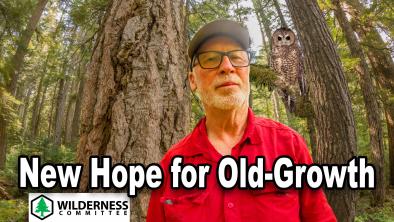Spotted owl issue raised in lake area
Chilliwack Times

Derrick Kramer and his family have been camping and visiting their cabin near Chilliwack Lake for four decades but now, clearcuts are ruining the experience.
"In 38 years it's the worst I've ever seen up there," Kramer told the Times Monday. "It's the most atrocious thing I've seen and I've seen a lot of logging. It breaks my heart."
Kramer owns a cabin in Post Creek, a recreational subdivision of 85 cabins adjacent to Chilliwack Lake Provincial Park, which is the easternmost development in the Chilliwack River Valley.
Kramer and others from the Post Creek Ratepayers Association are angry about a timber licence recently issued to Tamihi Logging that will see clearcuts in northern spotted owl habitat right across the road near the entrance to the provincial park.
"My main concern is the spotted
owl," Kramer said. "But secondly, it's the last thing people see driving to the provincial park. It's just disgusting."
The habitat of the northern spotted owl--an endangered species that's all but wiped out in the wild in southwestern B.C.--continues to be logged while those owls in captivity are having poor success at breeding.
For a second consecutive year, not one northern spotted owl in B.C.'s captive-breeding program gave birth to young.
"It's very unfortunate," said biologist Ian Blackburn, spotted owl recovery co-ordinator for B.C.'s Ministry of Environment. "This year we had two fertile eggs, but they failed to hatch."
The province has implemented a new management plan for the owls that allows logging of habitat in the Chilliwack Forest District.
Blackburn said the three categories of owl habitat recognized in the management plan include:
- 128,200 hectares of parks and other protected areas.
- 27,100 hectares of Wildlife Habitat Areas that are "managed future habitat areas." Logging is permitted in these areas but 15 or 40 of the largest trees per hectare must be retained in the stand, depending on the site, while maintaining 10 per cent of the overall forest.
- 71,400 hectares of Wildlife Habitat Areas managed as "long-term owl habitat areas" in which destruction of owl habitat is not allowed. Logging is allowed to "create and enhance" habitat for owls such as thinning second-growth.
Blackburn confirmed there are exemptions in the latter category that do, in fact, allow logging as a way to offset timber losses to companies in other areas for spotted owl protection.
Of the seven exemptions, five went to Tamihi Logging, the largest of which is 142 hectares at Ford Mountain and Post Creek in the Chilliwack River Valley.
Although the site has had logging in the past, it contains numerous mature Douglas fir and western red cedar trees exceeding one metre in diameter.
Area residents are upset at the pending logging there because they assumed that living next to a Wildlife Habitat Area for endangered spotted owls would reduce the likelihood of logging.
"It's really disturbing," said spokesman Glen Thompson of Friends of the Chilliwack River Valley. "Who thought putting a Wildlife Habitat Area in there would bring more logging?
"We thought it would be the opposite. This caught us off guard."
Joe Foy, national campaign director for the Wilderness Committee, described the rules governing "managed future habitat areas" to be "weak and lily-livered" and do nothing to address the pressing immediate habitat needs.
"We don't have 200 years," he said. "The owl is almost gone."
- with files from Larry Pynn, Vancouver Sun


